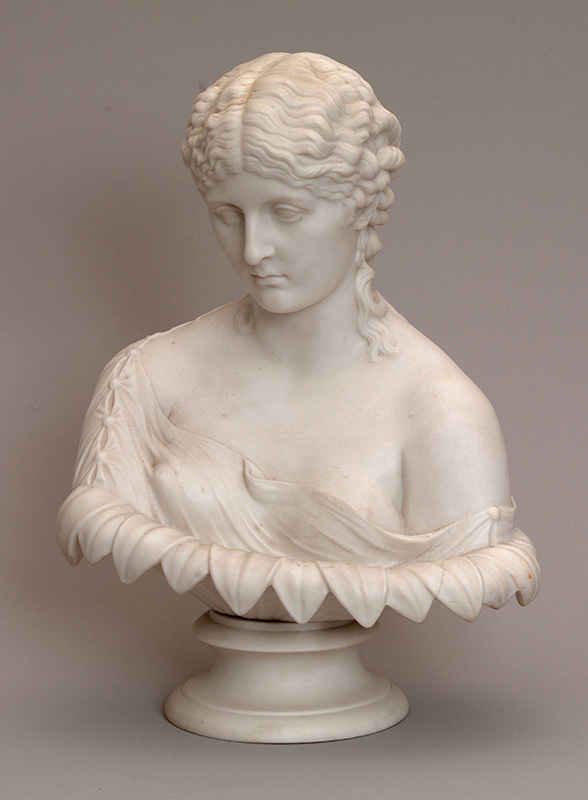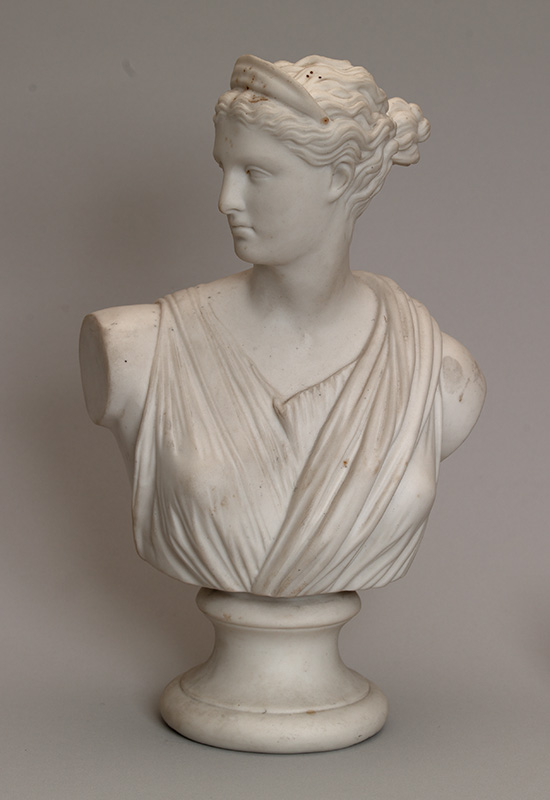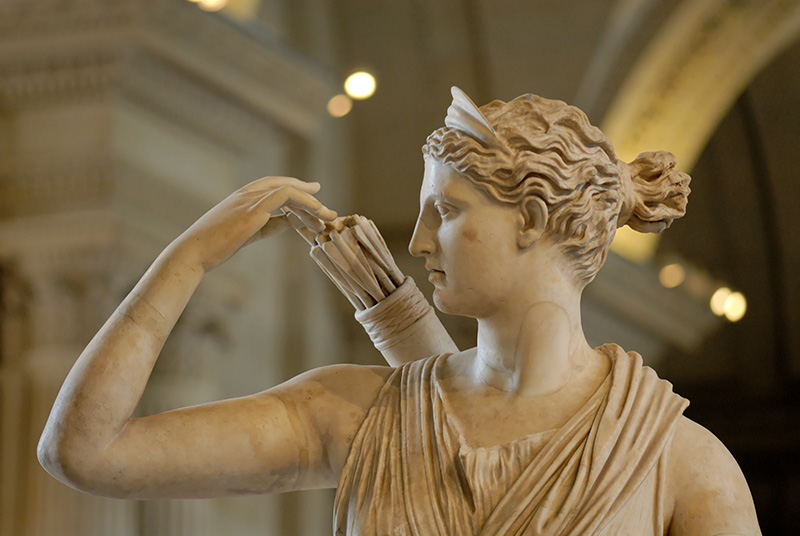American Classicism and Frederick Douglass’s Sculpture Collection
by Elizabeth S. Humphrey
Most scholars understand the influence of Classicism on the decorative arts produced during the 18th and 19th centuries. Classical forms and imagery influenced American architecture, furniture, visual art, and metalwork. Classical language and literature made their way into educational systems, public and private library collections, and theater production. While there were many avenues for one to engage with antiquity, most of these opportunities were not accessible to the majority of Black Americans, especially before the Civil War. Several factors contributed to this barrier of access, including the enslavement of Africans and African Americans as well as the prevailing belief that African Americans were inherently too inferior to comprehend Classical language, culture, and art. Despite these obstacles, there were, of course, free and enslaved African Americans who engaged with the classics. Frederick Douglass’s participation in American Classicism provides an opportunity to examine how and why Black Americans were attracted to this movement.
Frederick Douglass (1818–1895) began engaging with Classicism at an early age, first through the study of translated texts, like those found in The Columbian Orator (1817). His learning was self-taught and self-designed. He invoked these texts, debates, and histories when crafting his arguments and speeches advocating for abolitionism. After Douglass’s self-emancipation in 1838, his participation in Classicism evolved from consulting texts to actively collecting books and art related to the ancient world. Douglass’s Cedar Hill home, located in the Anacostia neighborhood of Washington, D.C., contains a private library housing countless books related to the Classics: ancient history, Greek and Latin textbooks, travel guides, and more. His home also contained sculpture inspired by Neoclassical influences and Classical examples, signaling his awareness of American Classicism and a desire to participate fully in this cult of antiquity.
Some of the sculptures contained in Douglass’s collection were Greco-Roman mythological figures such as Clytie, Mercury, and Psyche (figures 1 and 2). However, Douglass’s ownership of a Diana of Versailles bust and a miniature version of The Greek Slave carry special significance. Douglass’s Classically inspired sculptures highlight his knowledge of mythology, but Diana of Versailles (figure 3) perhaps demonstrates his appropriation of Classical meanings and their contemporary applications. Made after the original Greek bronze sculpture by Leochares (fl. 4th century BCE), a Roman copy of this sculpture is featured at the Louvre (figure 4). Diana was the Roman goddess of wild animals and the hunt and was considered a protector of the lower classes and the enslaved, as well as other guardianship roles. This association with protecting enslaved groups in Roman antiquity might have resonated with Douglass as a formerly enslaved individual. Perhaps Douglass’s acquisition of the bust symbolized his hopes for African Americans’ protection, emancipation, and full freedoms in the United States.
Douglass’s Greek Slave miniature (figure 5) highlights the widespread popularity of Hiram Powers’s depictions of an enslaved Greek woman captured by Turks during the Greek Independence War (see p. 40). Powers followed Neoclassical conventions of stoicism that prompted one to consider the human consequences of war. Douglass’s miniature documents the final iteration of this sculpture, where Powers swapped out the decorative chains for a realistic manacle, a decision that, as art historian Charmaine Nelson argues, had “pointed symbolic repercussions for the representation of blackness and slavery” derived from the sculpture.3 This iteration of The Greek Slave cemented abolitionists’ arguments about the relevance of the sculpture in antislavery discourse in the United States. As historian Margaret Malamud writes, “abolitionists quickly and angrily exposed the hypocrisy of supporting the Greek struggle for liberty against the Ottomans while simultaneously supporting African American slavery in the United States.”4 Again, Douglass’s intentional ownership of this version of the Neoclassical sculpture, containing an overt tie to chattel slavery in the United States, carried new meanings that aligned with his continual abolitionist efforts.
The sculptures discussed here, together with the library collection, suggest Douglass’s full participation in American Classicism. 19th-century African Americans debated the utility of the classics in their pursuit of freedom. Some, like Booker T. Washington, argued for a practical education and considered any participation in Classicism useless as it would not prepare freed Black Americans for the occupations available to them. Others such as Alexander Crummell opposed this idea of a “caste education,” instead arguing that Black Americans needed, and deserved, the “increase of his higher wants, of his mental and spiritual needs.”5 This increase, Crummell argued, was available by studying the classics and participating in Classicism. Douglass’s engagement with Classicism and his collection of sculpture is a little ironic given his stance in this debate. He championed a pragmatic education for African Americans, which would equip them with tangible skills and trades for the growing industries. Douglass’s pursuit of the classics, despite his stance against the benefits of a Classical education, reveals his awareness of its importance and esteem within the dominant American culture. I believe his desire to collect Classical texts and sculpture demonstrates his desire to participate fully in American cultural values and be recognized as an American of equal status to his white counterparts.
- The study of Black Americans’ engagement with the Classics, or “Classica Africana,” a term coined by Michele Ronnick in 1996, is a relatively recent subfield of study. Most of this scholarship focuses on turn-of-the-20th century academicians and intellectuals, the influence of Classicism on authors, and scholarship produced by Black classicists. For recent discourse on Black Classicism, see Emily Greenwood, “Re-rooting the classical tradition: new directions in black classicism,” Classical Receptions Journal 1:1 (2009): 87–103; EOS Africana, a scholarly society dedicated to Africana Receptions of Ancient Greece and Rome, https://www.eosafricana.org; and the exhibit 15 Black Classicists (2018), curated by Michele Valerie Ronnick and organized by the Blackburn Gallery of Art at Howard University and the Center for Hellenic Studies, Harvard University.
- William L. Andrews and William S. McFeely, eds., Frederick Douglass: Narrative of the Life of Frederick Douglass, an American Slave, Written by Himself (New York: W.W. Norton & Company, 1997), p. 32.
- Charmaine Nelson, The Color of Stone: Sculpting the Black Female Subject in Nineteenth-Century America (Minneapolis: University of Minnesota Press, 2007), p. 79.
- Margaret Malamud, African Americans and the Classics: Antiquity, Abolition & Activism (London and New York: I.B. Tauris & Co. Ltd, 2016), pp. 81-82.
- Ibid, p. 50.
Elizabeth S. Humphrey is a contributing writer for the Decorative Arts Trust and a PhD candidate in Art History at the University of Delaware.
A print version of this article was published in The Magazine of the Decorative Arts Trust, one of our most popular member benefits. Join today!





